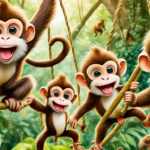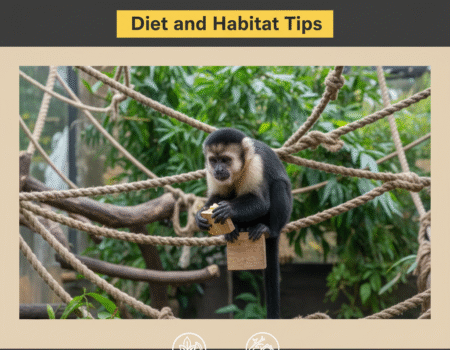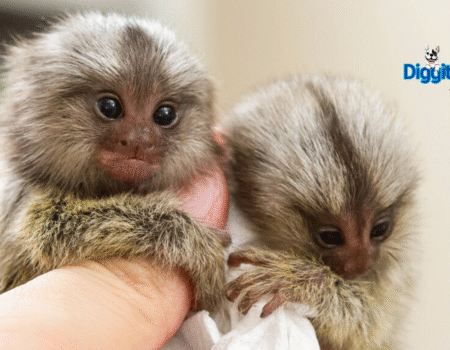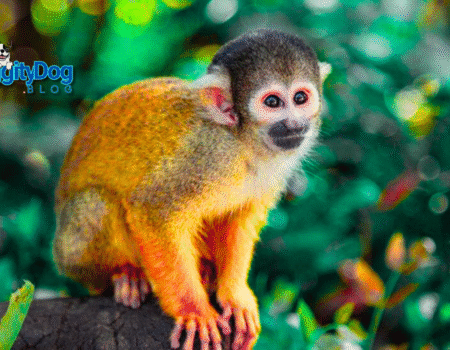Get ready to fall in love with some of the most adorable primates on the planet – cute monkey breeds that will melt your heart! These delightful creatures come in a variety of species, each with its own unique charm. From their playful antics to their lovable features, it’s hard not to be captivated by these amazing animals.
One of the cutest monkey breeds you’ll encounter is the Cotton Top Tamarins. With their squirrel-sized bodies and distinctive white fur on their heads, they are simply irresistible. It’s no wonder they are often referred to as the epitome of cuteness in the primate world.
But these adorable creatures are more than just a pretty face. The Cotton Top Tamarins are also known for their unique family dynamics. Unlike many other monkey species, females usually give birth to twins, an extraordinary occurrence in the primate world. And just days after giving birth, these incredible mothers become pregnant again! But it doesn’t end there. The males in the group play a crucial role in carrying and caring for the young, showcasing their strong family bonds.
Unfortunately, the Cotton Top Tamarins are also an endangered species. That’s why the work of conservation biologist Anne Savage is so vital. She has dedicated her life to studying and conserving these precious monkeys in the wild, ensuring that future generations can continue to adore them.
Different Monkey Breeds Across the World
Monkey breeds are diverse and can be found in various regions across the globe. Each breed has its own unique characteristics and charm. Let’s explore some popular monkey breeds and where they can be found:
Bhutan
In Bhutan, you can encounter the Eastern Assamese Macaque, known for its expressive faces and delightful playfulness. Additionally, the Grey Langur, with its striking silver-colored fur, can be spotted in the enchanting Punakha Valley.
Cultural Triangle, Sri Lanka
If you visit the Cultural Triangle region in Sri Lanka, keep an eye out for the adorable Toque Macaque. These playful creatures are known for their mischievous antics and distinctive reddish-brown fur.
India and Nepal
The Rhesus Macaque is a popular monkey species found in both India and Nepal. Known for their adaptability and urban presence, you can often encounter them in temples in Kathmandu, Nepal, and other parts of India.
Vietnam and Thailand
Halong Bay in Vietnam is home to the stunning Golden-Headed Langur, with its charismatic golden fur. Chiang Mai in Thailand is where you can spot the Long-Tailed Macaque, recognized for its long, graceful tail and agile tree-climbing abilities.
Japan
In Japan, the snow monkeys, or Japanese Macaques, can be found in Kyoto and Koyasan. These remarkable monkeys are known for their resilience in enduring cold weather and their relaxing hot spring baths.
| Monkey Breed | Location |
|---|---|
| Eastern Assamese Macaque | Bhutan |
| Grey Langur | Punakha Valley, Bhutan |
| Toque Macaque | Cultural Triangle, Sri Lanka |
| Rhesus Macaque | India and Nepal |
| Golden-Headed Langur | Halong Bay, Vietnam |
| Long-Tailed Macaque | Chiang Mai, Thailand |
| Japanese Macaque (Snow Monkey) | Kyoto and Koyasan, Japan |
These are just a few examples of the diversity of monkey breeds found worldwide. Each breed has its own unique characteristics, contributing to the wonder and fascination of these cute and charismatic creatures.
Conservation Efforts for Monkey Species
Monkey species, including cute and exotic primates, face numerous challenges from illegal pet trade and habitat destruction. To protect these vulnerable creatures, conservation efforts are essential. One organization taking significant steps to conserve monkey species is Proyecto Titi, which focuses on the preservation of Cotton Top Tamarins in Colombia. Proyecto Titi discourages forest destruction and creates economic opportunities for local communities, promoting sustainable practices that benefit both the monkeys and the environment.
In addition to conservation initiatives, raising awareness about the unique needs of monkey species is crucial. It is essential to educate the public about the challenges of keeping monkeys as pets. Despite their appeal, many monkey breeds are not suitable for domestication and can suffer physically and mentally when confined as pets. By supporting conservation organizations and spreading awareness, we can contribute to the well-being of monkey species and their natural habitats.
“The greatness of a nation and its moral progress can be judged by the way its animals are treated.”
– Mahatma Gandhi
The Cost of Illegal Pet Trade
The illegal pet trade poses a grave threat to monkey species worldwide. Demand for exotic primate breeds fuels this illicit industry, leading to the capture and trafficking of these animals. However, the trade often involves cruel methods of capture and transportation, causing distress and harm to the monkeys. Ultimately, supporting legal, ethical ways to appreciate and observe monkeys in their natural habitats is crucial for their well-being and conservation.
Educating the Public
One key aspect of monkey conservation is educating the public about the unique needs and challenges of these animals. Disseminating knowledge about monkey behavior, habitat requirements, and conservation efforts helps foster a deeper understanding of the value and importance of protecting these species. By emphasizing the unsuitability of monkeys as pets, we can discourage the demand for exotic primate breeds and promote responsible interactions with these animals.
Supporting Conservation Organizations
Supporting conservation organizations is a tangible way to contribute to the preservation of monkey species. These organizations work tirelessly to protect habitats, combat illegal trade, and promote sustainable practices. By volunteering, donating, or participating in fundraising events, individuals can actively support the essential work being done to safeguard these adorable and fascinating creatures.
The Unique Needs of Monkey Species
Understanding the unique needs of monkey species is crucial for their well-being and successful conservation. Monkey breeds have specific physical, social, and environmental requirements that must be met for them to thrive. Without suitable habitats, proper nutrition, and opportunities for social interaction, these animals may suffer from physical and mental health issues. By spreading awareness about their unique needs, we can encourage responsible conservation practices and ensure the long-term survival of monkey species.
Let’s play our part in protecting monkey species by supporting conservation efforts, promoting education, and cultivating a greater appreciation for the incredible diversity and value of these exotic primates.
Unique Characteristics of Cute Monkey Breeds
Each cute monkey breed has its own unique characteristics. From the white head crests of Cotton Top Tamarins to the reddish-brown fur of the Toque Macaques, these adorable primates exhibit distinct features that make them stand out. The Grey Langur and Golden-Headed Langur both have a grayish coat, but the latter boasts an extravagant tail that adds to its charm. As for the Long-Tailed Macaque, its name says it all – it sports a long tail that perfectly complements its body length. These remarkable attributes contribute to the overall cuteness and appeal of each monkey breed.
“The unique characteristics of cute monkey breeds make them even more irresistibly adorable. From their distinctive head crests to the length of their tails, these charming primates never fail to captivate our hearts.” – Anne Savage, Conservation Biologist
Monkeys Around the World: Popular Destinations
If you’re interested in observing monkeys in their natural habitat, there are several popular destinations known for their diverse monkey populations. These destinations offer a chance to see some of the best monkeys to keep as pets and popular monkey breeds. Let’s explore some of these incredible places:
Bhutan
Located in the eastern Himalayas, Bhutan is home to a variety of monkey species. The Eastern Assamese Macaque and the Toque Macaque are among the fascinating monkeys you can encounter while exploring the lush landscapes of Bhutan.
Sri Lanka
A trip to Sri Lanka’s Cultural Triangle region provides an opportunity to observe the charming Toque Macaque in its natural habitat. This species is known for its striking appearance and playful behavior.
Rajasthan, India
If you want to witness the common Rhesus Macaque in action, Rajasthan, India, is the place to be. These monkeys can be found roaming the streets, temples, and forts of this culturally rich region.
Kathmandu, Nepal
Temples in Kathmandu, Nepal, offer a unique chance to observe the assertive Rhesus Macaque up close. These monkeys are known for their cheeky antics and fascinating social dynamics.
Other Destinations
In addition to the aforementioned destinations, there are several other places where you can spot different monkey species. These include Punakha Valley in Bhutan, Halong Bay in Vietnam, Chiang Mai in Thailand, and Kyoto and Koyasan in Japan. Each of these locations offers a distinct experience, allowing you to witness the beauty and diversity of popular monkey breeds.
Embark on an adventure to these popular destinations and immerse yourself in the captivating world of monkeys. Witness their playful antics, learn about their unique behaviors, and gain a deeper appreciation for these remarkable creatures.
Monkey Conservation and Sustainable Practices
Conservation efforts for monkey species are not limited to protecting their natural habitats. Promoting sustainable practices plays a crucial role in ensuring their survival and the well-being of the environment. By integrating conservation with sustainable initiatives, we can create a harmonious relationship between monkey species, local communities, and the ecosystems they inhabit.
One example of these sustainable practices is the work of Proyecto Titi in Colombia. This organization supports forest conservation by organizing businesses for women to create environmentally friendly bags from recycled plastics. These initiatives provide income opportunities for local communities while reducing pollution and promoting a greener future.
Similar endeavors can be found in other countries as well. In Kenya, organizations support sustainable tourism initiatives that not only raise awareness about the importance of monkey conservation but also provide economic benefits to local communities. Rwanda’s efforts involve sustainable agroforestry, which helps protect monkey habitats and improves the livelihoods of farmers.
Sustainable Practices for Monkey Conservation:
- Supporting local communities through economic opportunities that promote forest conservation
- Encouraging sustainable tourism and responsible travel
- Promoting initiatives for recycling and reducing plastic waste
- Implementing sustainable agroforestry to protect monkey habitats
Sustainability and conservation go hand in hand. By adopting sustainable practices, we can protect the natural habitats of monkey species, preserve biodiversity, and create a better future for both animals and humans.
By embracing sustainable initiatives and raising awareness about the importance of conservation, we can ensure the continued existence of monkey species and the preservation of their habitats. Together, we can make a positive impact on our environment and contribute to the well-being of these incredible creatures.
Monkey Watching Tips and Etiquette
When you embark on the adventure of observing monkeys in their natural habitats, it is crucial to follow certain guidelines to ensure the well-being of these fascinating animals and prioritize your own safety. By being a responsible and considerate observer, you can enjoy the beauty of these creatures while minimizing any potential harm. Here are some essential monkey watching tips and etiquette to keep in mind:
1. Maintain a Respectful Distance
To respect the monkeys’ space and minimize stress, it is important to maintain a respectful distance. Avoid crowding them or getting too close, as this can disrupt their natural behavior and potentially provoke aggression.
2. Avoid Feeding or Touching the Monkeys
While it might be tempting to offer food or try to touch the monkeys, it is best to resist this urge. Feeding them can disrupt their natural diet and cause dependency, leading to health issues. Touching them can also transmit diseases and create unnecessary stress for the animals.
3. Observe Quietly and Avoid Sudden Movements
Monkeys are highly sensitive to sudden movements and loud noises. To avoid startling them or causing unnecessary stress, observe quietly and avoid making sudden, abrupt movements. Move slowly and calmly, respecting their natural environment.
4. Respect Local Regulations and Guidelines
Each location may have specific regulations and guidelines for monkey watching. It is crucial to familiarize yourself with these rules and respect them to ensure the well-being of the animals and maintain the sustainability of their habitats.
“By being a responsible observer, you can contribute to the conservation efforts and help protect these incredible creatures for future generations.”
Remember, the ultimate goal is to appreciate and learn about these amazing animals while minimizing any negative impact on their lives. By being a respectful and responsible observer, you can contribute to the conservation efforts and help protect these incredible creatures for future generations.
| Monkey Watching Tips and Etiquette |
|---|
| Maintain a respectful distance |
| Avoid feeding or touching the monkeys |
| Observe quietly and avoid sudden movements |
| Respect local regulations and guidelines |
Monkey Conservation Travel Experiences
For those who have a deep love for monkeys and want to combine it with unique travel experiences, there are various opportunities available. Several organizations provide volunteer programs that allow you to actively participate in monkey conservation efforts. These programs often involve tasks such as habitat restoration, educational outreach, or assisting with research projects.
Additionally, certain regions offer ecotourism initiatives that enable visitors to support conservation financially while experiencing up-close encounters with monkeys in their natural habitats. These travel experiences provide a fabulous opportunity to learn about monkey conservation firsthand and make a positive impact on their well-being.
“Volunteering in monkey conservation efforts not only allows me to contribute to a noble cause but also provides me with a unique way to immerse myself in the beauty of these incredible creatures. It’s an experience like no other!”
If you are an enthusiast of exotic primate breeds or popular monkey breeds, participating in a monkey conservation travel experience will allow you to witness the tireless efforts made to protect these fascinating animals and their habitats.
Whether it’s assisting in habitat restoration projects in Borneo, contributing to educational campaigns about monkey conservation in Costa Rica, or conducting research on rare monkey species in Tanzania, there are endless possibilities to make a meaningful difference while fulfilling your passion for monkeys.
Take a look at the table below for a glimpse of some notable monkey conservation travel experiences:
| Destination | Activities |
|---|---|
| Borneo, Indonesia | Participate in habitat restoration projects for Orangutans and Proboscis Monkeys |
| Costa Rica | Assist in educational campaigns about conservation for Squirrel Monkeys and Howler Monkeys |
| Tanzania | Conduct research on rare Monkey species such as the Zanzibar Red Colobus Monkey |
By joining these conservation travel experiences, you not only get to explore stunning destinations but also contribute to the preservation of exotic primate breeds and popular monkey breeds. It’s a unique opportunity to make a positive impact on the lives of these incredible creatures and inspire others to do the same.
The Importance of Monkey Conservation
Monkey conservation plays a vital role in maintaining the well-being of these adorable creatures and the overall health of ecosystems. From seed dispersal to pollination, monkeys contribute significantly to the balance and diversity of their habitats. By protecting monkey species and their natural environments, we can ensure the long-term sustainability of our ecosystems and preserve precious biodiversity.
Did you know? Monkeys are often classified as umbrella species, meaning their conservation efforts indirectly protect other species that share the same habitat.
“Monkeys are key players in nature’s symphony, and their disappearance would create an imbalance that could have far-reaching consequences.” – Dr. Jane Goodall
Unfortunately, monkey species face significant threats such as illegal poaching, habitat destruction, and the exotic pet trade. This is where awareness and responsible action come into play. By raising awareness about the importance of monkey conservation, we can combat these threats and promote the well-being of these incredible creatures.
Every individual can make a difference in monkey conservation. Supporting reputable conservation organizations through donations and volunteering contributes to crucial research and conservation programs. Spreading awareness about the challenges faced by monkeys and their habitats helps educate others and encourages responsible behavior.
Conservation Success Story: Cotton Top Tamarins
One heartwarming example of successful monkey conservation is the Cotton Top Tamarins. These adorable primates, known for their distinctive white head crests, are native to Colombia and were listed as critically endangered. Conservation efforts, led by organizations such as Proyecto Titi, have helped increase the population of Cotton Top Tamarins through habitat protection and reintroduction programs.
Wondering how you can contribute to monkey conservation?
- Support reputable organizations dedicated to monkey conservation
- Spread awareness on social media and in your community
- Make responsible choices regarding pet ownership – research and avoid supporting the exotic pet trade
- Encourage sustainable practices that protect monkey habitats
| Threats | Impact |
|---|---|
| Illegal Poaching | Reduction in population and disturbance of natural behavior |
| Habitat Destruction | Loss of food sources and shelter, fragmentation of habitats |
| Exotic Pet Trade | Stress, disease, and mistreatment of monkeys |
By prioritizing monkey conservation, we not only safeguard the future of these cute monkey breeds but also contribute to the overall health and sustainability of our planet. Let’s work together to protect and preserve these incredible creatures for generations to come.
Embracing the Wonder of Cute Monkey Breeds
Cute monkey breeds captivate us with their irresistible charm and fascinating behaviors. Each unique species offers a delightful glimpse into the enchanting world of primates.
Take the Cotton Top Tamarins, for example, with their endearing appearance and the exceptional feat of giving birth to twins. These playful creatures form strong family bonds, and the males actively participate in nurturing their young. Their ability to adapt and thrive in their natural habitat is truly remarkable.
Another adorable species is the Long-Tailed Macaque, known for their mischievous antics and agile tree-climbing skills. They bring joy and laughter to their observers as they swing effortlessly through the canopies with their long, expressive tails.
Last but not least, the elegant Golden-Headed Langur captures the imagination with their dazzling appearance and extravagant tails. These majestic creatures exemplify the splendor of the animal kingdom, enticing us to marvel at their beauty.
By embracing the wonder of these cute monkey breeds, we cultivate a deeper connection with nature and the importance of their preservation. Let us unite in our efforts to protect and conserve these amazing creatures, ensuring a future where they continue to enchant and inspire us.
FAQ
What are some cute monkey breeds?
Some cute monkey breeds include Cotton Top Tamarins, Toque Macaques, Grey Langurs, and Golden-Headed Langurs.
Where can I find different monkey breeds across the world?
Monkey breeds can be found in various regions such as Bhutan, Sri Lanka, India, Nepal, Vietnam, Thailand, and Japan.
What efforts are being made for the conservation of monkey species?
Conservation organizations like Proyecto Titi work towards protecting monkey species by discouraging habitat destruction and providing economic opportunities for locals.
What are the unique characteristics of cute monkey breeds?
Cute monkey breeds have unique characteristics such as white head crests, reddish-brown fur, extravagant tails, and long tails that match their body length.
What are some popular destinations to observe monkeys?
Some popular destinations to observe monkeys include Bhutan, Sri Lanka, India, Nepal, Vietnam, Thailand, and Japan.
How can conservation efforts be combined with sustainable practices?
Conservation efforts can be combined with sustainable practices by supporting local communities through economic opportunities that promote forest conservation.
What are some tips for monkey watching?
When watching monkeys, it’s important to keep a respectful distance, avoid feeding or touching them, observe quietly, and respect local regulations or guidelines.
Are there any monkey conservation travel experiences available?
Yes, there are volunteer programs and ecotourism initiatives that allow individuals to participate in monkey conservation efforts or support them financially while experiencing close encounters with monkeys in their natural habitats.
Why is monkey conservation important?
Monkey conservation is important not only for the well-being of these adorable creatures but also for maintaining biodiversity and the overall health of ecosystems.
How can I develop a deeper connection with cute monkey breeds?
You can develop a deeper connection with cute monkey breeds by appreciating and understanding their unique characteristics and by supporting conservation efforts.










No Comment! Be the first one.